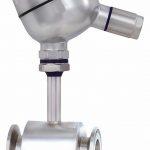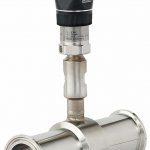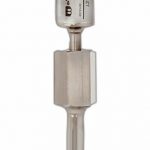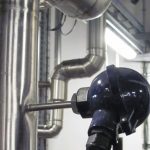Grinding, often called micronisation, is a critical part of many modern pharmaceutical manufacturing processes. The size of the particles comprised in the pill, tablet or capsule is crucial for the bioavailability of a drug – how fast the active ingredient dissolves and how long it stays in a person’s system. A very fine particle size often means higher bioavailability. This is typically the industry preference because the medication requires a smaller proportion of active ingredients. This, in turn, translates into fewer side effects for the patient and, simultaneously, lower production costs for the manufacturer.
With the new design for its compact micronisation system, this OEM was seeking to improve product quality and minimise contamination. Instrumentation connection methods had been found to be contributing decisively to these issues. Depending on how these components are installed, proper cleaning can be difficult, which invites the risk of contamination. Or, they can be positioned in a way that interferes with media flow, which can impact on product quality.
Measuring points
Wika collaborated with this OEM to develop the pressure and temperature measuring points required for their new micronisation system as well as for being in accordance with the design specifications. These requirements spoke against adapting the process with tees, which tend to be the norm in numerous production processes in the pharmaceutical industry. Instead, in-line measurement technology was chosen for both measurands. This OEM now uses in-line diaphragm seals in combination with a pressure transmitter to control the pressure in the micronisation system. The seals are mounted directly into the process line. With their cylindrical diaphragm design, they allow a laminar flow of process media, so that turbulences are not detrimental to the pressure measurement.
The same method is used to monitor the process temperature. In-line resistance thermometers (Pt100) were selected for this purpose. The stem, which acts like a thermowell and shields the instrument from negative effects in the process environment, is welded into the pipe and likewise does not interfere with the media flow.
Ensuring product quality
Apart from preventing potential blockages in the process, the in-line measurement technology above all helps ensure product quality through optimal cleanability. The pressure and temperature measuring points have no dead spaces or branch legs that cannot be cleaned – two of the most frequent causes of contamination. Branch legs are common in instrumentation with tee connections because the air pockets which can form are capable of surviving even prolonged cleaning. These bubbles prevent cleaning solution from wetting all surfaces.
The use of in-line diaphragm seals and resistance thermometers has also reduced the risk of contamination elsewhere. The tri-clamp fittings which are normally used to mount instruments in tees, and which are a potential cause of contamination, are eliminated with this method: under-tightening of a gasket can lead to process media escaping or to unwanted crevices. Over-tightening, on the other hand, can prompt gasket breakdown, which can force small pieces of the gasket into the process or restrict pipe drainage.
Fewer process interventions
In addition to the resulting calibration process, the new measuring point concept also improves quality assurance. Thermometers generally have shorter inspection intervals than pressure gauges. Whereas the diaphragm seal systems must be completely removed from the pipe for calibration, with the temperature measuring points only the resistance thermometers have to be dismounted. The thermowells make sure the process remains closed throughout. That means much less incidence per year of potentially introducing ambient particles and exposing the manufacturer to other costly risks.
Moreover, calibration with the process sealed has economic and ecological side-effects. It saves working time as well as water and energy because there is no need to clean the piping and sterilise the system after checking the instrument.
Conclusion: In-line measurement technology significantly reduces the risks during pharmaceutical processes. Although there is no doubt that the improved product quality entails higher capital costs, these are more than offset in the long run by the lower costs of operation.
Online search: cpp0219wika














